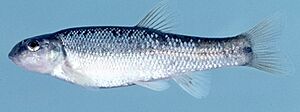Exoglossum laurae facts for kids
Quick facts for kids Exoglossum laurae |
|
|---|---|
 |
|
| Conservation status | |
| Scientific classification | |
| Synonyms | |
|
The tonguetied minnow (scientific name: Exoglossum laurae) is a type of minnow fish. It lives in rivers and streams across North America. This small fish is known for its unique mouth and its need for very clean water.
Contents
What Does the Tonguetied Minnow Look Like?
This minnow is usually dark gray to brown-black. It has small purple spots all over its body and a white belly. These fish are quite small, growing to be about three to five inches long. That's roughly the length of a smartphone!
The tonguetied minnow gets its name from its special mouth. Its lower jaw is partly uncovered by its lips. This makes its mouth look a bit unusual. The mouth is small and opens horizontally.
This minnow has several fins. It has eight rays in its dorsal fin (on its back). Its anal fin (on its underside) has seven rays. The pelvic fins (near its belly) have eight rays. Its pectoral fins (on its sides) have between thirteen and seventeen rays.
Where Does the Tonguetied Minnow Live?
The tonguetied minnow lives in parts of Ontario, Canada. It also lives in the Northeastern United States. In the state of Ohio, this minnow has only been found in two rivers. These are the Great Miami River and the Little Miami River. The minnows in Ohio are quite far from other groups. Because of this, they are considered a special type, or subspecies.
This minnow needs very clean water to survive. It cannot live in muddy or cloudy waters. It also needs a river bottom made of clean rocks. The river banks must have lots of trees. These trees help keep the water cool and clean. The minnow needs water that is somewhat cool to live comfortably.
Tonguetied Minnow Behavior
How the Tonguetied Minnow Hunts
The tonguetied minnow is an active hunter. This means it will leave its safe hiding spots to find food. It might hunt alone or in small groups. Its main food source is small creatures that live in the water. These are called aquatic invertebrates, like insect larvae.
Reproduction and Life Cycle
Tonguetied minnows usually reproduce around the month of May. The male minnows are very busy during this time. They build nests using small pebbles on the river bottom. These nests are important because they protect the eggs after they are laid.
Male minnows are also very protective. They will actively defend their pebble nests from anything that might harm the eggs. Scientists have seen eggs at different stages of development in the same nests. This suggests that mating probably happens over a longer period of time.
Is the Tonguetied Minnow in Danger?
The tonguetied minnow has a large population. It is quite common in the areas where it lives. However, this minnow has lost some of its natural homes. This is mainly due to water pollution. Another problem is the straightening of rivers, which is called channelization.
These issues have caused the total number of tonguetied minnows to go down. But, experts do not think it is currently at high risk. This is because its population is still large and generally stable.


